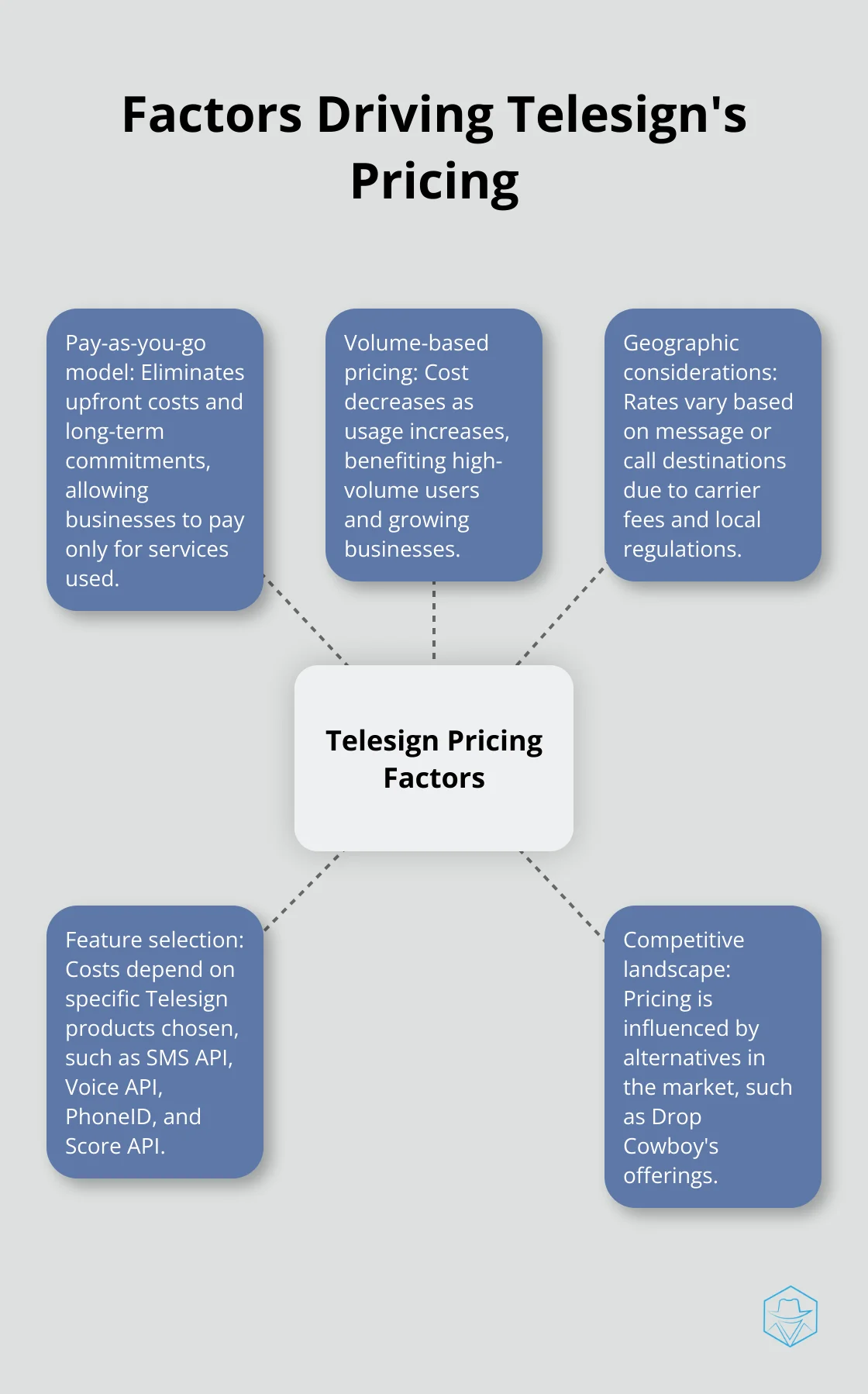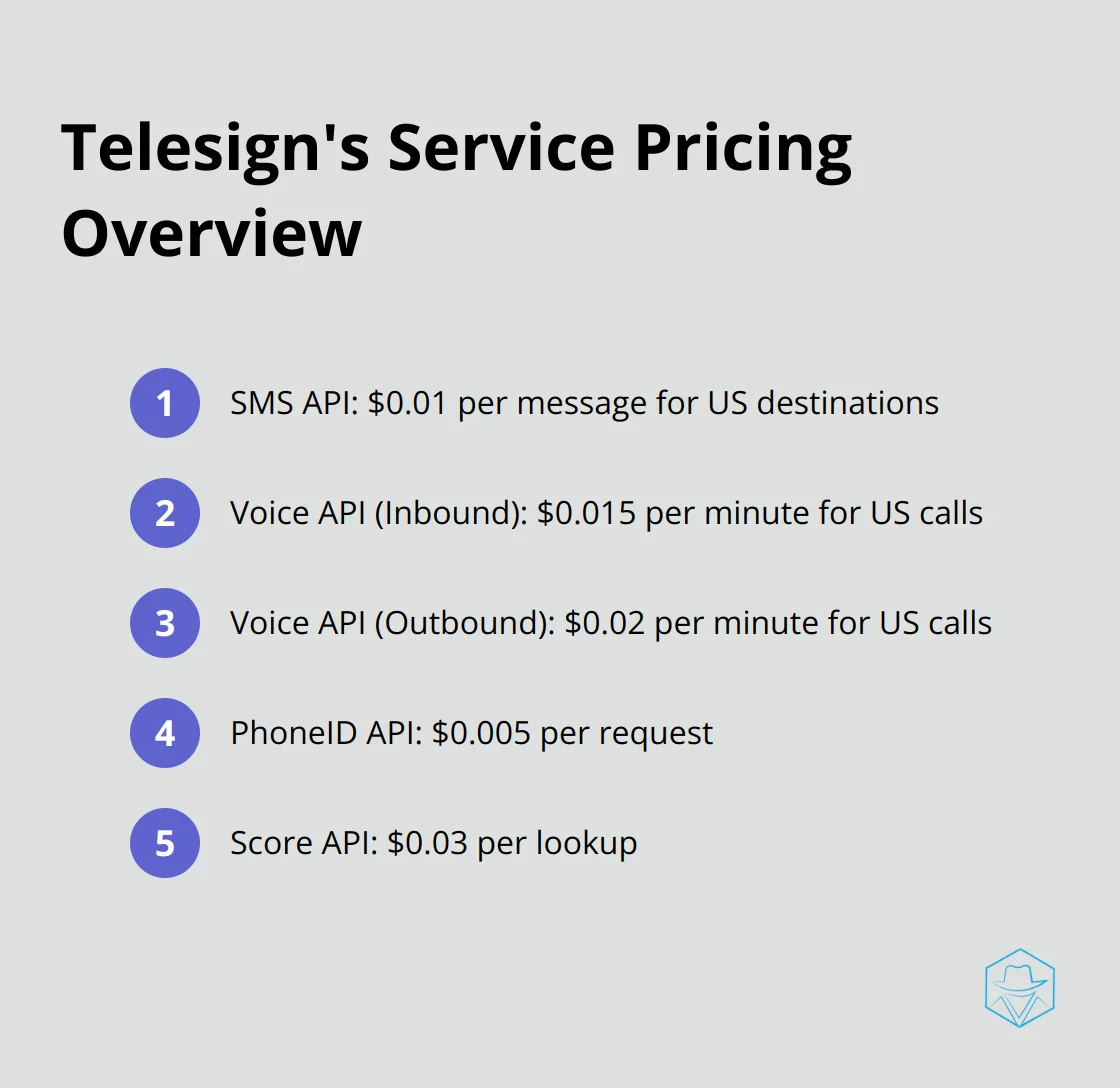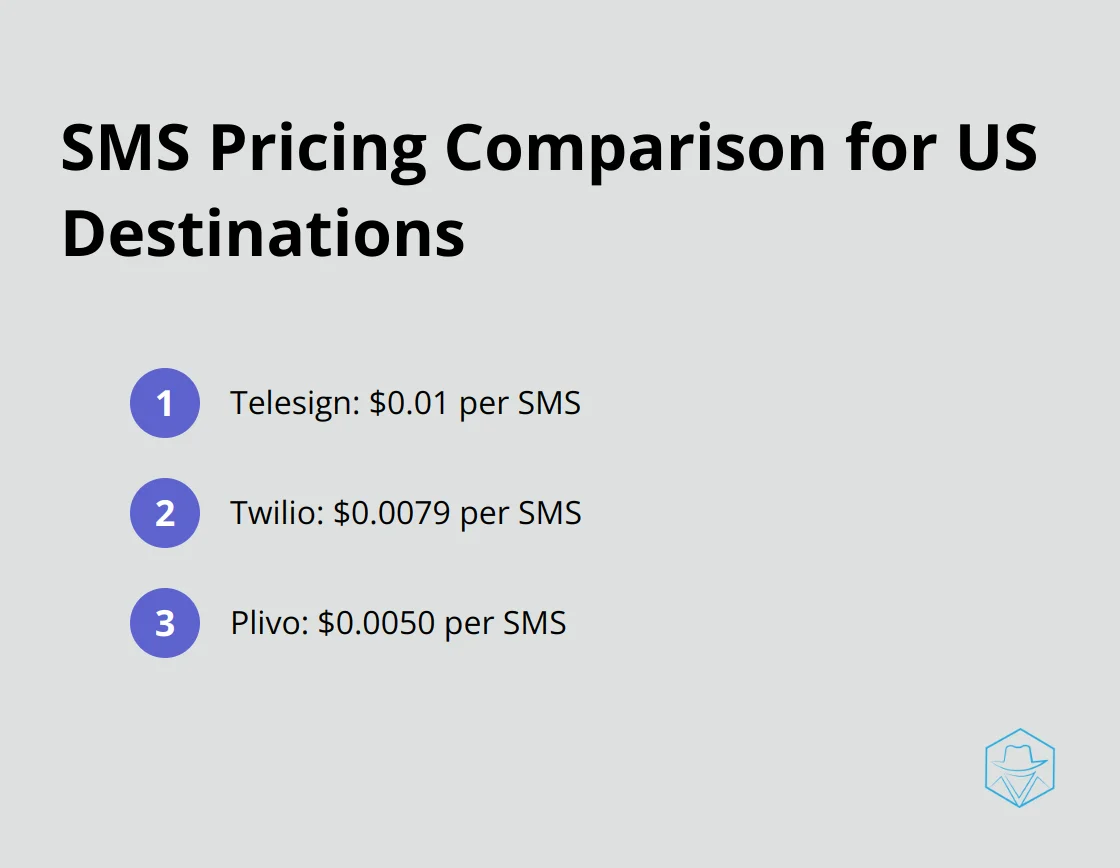How Much Does Telesign Cost?

At Drop Cowboy, we understand the importance of finding cost-effective communication solutions for businesses. Telesign is a popular choice, but many are curious about its pricing structure.
In this post, we’ll break down Telesign’s costs, compare them to alternatives, and help you determine if it’s the right fit for your budget. Let’s explore the Telesign price landscape and what it means for your business.
What Drives Telesign’s Pricing?
Pay-as-you-go Model
Telesign operates primarily on a pay-as-you-go model. This approach eliminates upfront costs and long-term commitments. Businesses pay only for the services they use, which proves advantageous for companies with fluctuating communication needs or those new to API-based communication solutions.
Volume-based Pricing
The cost of Telesign’s services decreases as usage increases. High-volume SMS senders or frequent API callers benefit from lower per-unit costs. This scalability appeals to growing businesses (especially those experiencing rapid expansion).
Geographic Considerations
Telesign’s pricing varies based on message or call destinations. Rates for SMS or voice calls to certain countries may be higher due to carrier fees and local regulations. When estimating costs, it’s important to consider your target audience’s location (this can significantly impact your overall expenses).
Feature Selection
The specific Telesign products you choose impact your overall costs. Core offerings include SMS API, Voice API, PhoneID, and Score API. Each service has separate pricing, allowing you to customize your package to your exact needs. For example, if you only need SMS capabilities, you won’t pay for unused voice features.
Competitive Landscape
While Telesign offers competitive pricing, it’s worth exploring alternatives. Drop Cowboy, for instance, provides similar services with additional features like Mimic AI™ and Smart Delivery™, often at a more cost-effective rate. A thorough comparison of options will help you make an informed decision.

To understand how these pricing factors translate into actual costs, let’s examine the breakdown of Telesign’s service costs in the next section.
What Does Telesign Actually Cost?
Telesign’s pricing structure involves multiple factors. This section breaks down the costs for their main services to provide a clearer picture.
SMS API Pricing
Telesign’s SMS API pricing begins at $0.01 per message for US destinations. However, this rate increases significantly for international numbers. For instance, sending an SMS to Canada costs $0.0235, while the UK is priced at $0.0435 per message. These rates can accumulate rapidly for businesses with a global customer base (especially those sending high volumes of messages).
Voice API Costs
The Voice API from Telesign charges per minute. US rates start at $0.015 for inbound calls and $0.02 for outbound calls. International rates vary widely, with some countries costing over $0.50 per minute. This pricing structure can make voice communications expensive for certain businesses (particularly those with international clientele).
PhoneID and Score API Pricing
Telesign’s PhoneID API, which provides phone number intelligence, starts at $0.005 per request. The Score API, used for fraud risk assessment, begins at $0.03 per lookup. While these amounts seem small individually, they can add up quickly for businesses that perform frequent checks.
Additional Costs to Consider
Telesign includes charges for features like number lookup ($0.005 per request) and SMS sender IDs (prices vary by country). They also implement a minimum monthly spend requirement, which may not suit smaller businesses or those with inconsistent usage patterns.
Comparing Costs
When evaluating Telesign’s pricing, it’s crucial to consider alternatives. Drop Cowboy, for example, offers competitive rates for similar services, often with additional features included in the base pricing. This comparison becomes particularly important when factoring in Telesign’s additional costs and minimum spend requirements.

As we move forward, let’s examine how Telesign’s pricing compares to other providers in the market and what this means for businesses of different sizes.
How Do Telesign’s Costs Stack Up?
Pricing Landscape
Telesign’s SMS rates start at $0.01 per message for US destinations, which positions them competitively but not as the lowest-priced option in the industry. Twilio’s base rate for US SMS is $0.0079, while Plivo offers rates as low as $0.0050 per message. Telesign’s international rates can exceed those of some competitors, which may impact businesses targeting a global audience.

For voice services, Telesign’s starting rate of $0.015 per minute for inbound US calls aligns with industry standards. Their outbound rate of $0.02 per minute, however, surpasses some alternatives. (Plivo, for instance, provides outbound voice calls starting at $0.0065 per minute.)
Value Beyond Price
Telesign’s value proposition extends beyond pricing alone. Their emphasis on security and fraud prevention through services like PhoneID and Score API distinguishes them in the market. These features prove particularly valuable for businesses in finance, e-commerce, or any sector where user verification is essential.
Drop Cowboy emerges as a top choice for businesses seeking comprehensive communication solutions, offering similar security features along with innovative tools like Mimic AI™ and Smart Delivery™, often at more competitive rates.
Cost-Effectiveness Across Business Sizes
Small businesses or startups might find Telesign’s pay-as-you-go model attractive as it eliminates significant upfront investment. However, the minimum monthly spend requirement could deter those with very low volume needs.
Medium-sized businesses can benefit from Telesign’s volume-based discounts as their communication needs expand. The scalability of pricing can result in significant savings as usage increases.
Large enterprises with high-volume needs might reap the most benefits from Telesign’s pricing structure. The substantial discounts for bulk usage can lead to considerable cost savings. (These organizations should carefully evaluate their international communication needs, as Telesign’s higher rates for some countries could offset these savings.)
Hidden Costs and Considerations
When comparing Telesign to alternatives, it’s important to look beyond base rates. Additional charges for features like number lookup ($0.005 per request) and varying SMS sender ID prices can accumulate. Some competitors, including Drop Cowboy, offer more transparent pricing models with fewer add-on fees.
Moreover, while Telesign’s fraud prevention tools are robust, they incur additional costs. The Score API, for example, starts at $0.03 per lookup. Businesses should factor in these expenses when calculating the total cost of ownership.
Final Thoughts
Telesign’s pricing structure offers flexibility with its pay-as-you-go model and volume-based discounts. However, the Telesign price landscape can become complex, especially when considering international messaging and additional features. Businesses must evaluate their communication needs, target audience locations, and growth projections carefully before committing to Telesign.
While Telesign provides robust security features, these come at an additional cost that companies need to factor into their total investment. For many organizations, especially those that prioritize security and scalability, Telesign can be a solid choice (but it’s essential to consider the full spectrum of costs, including potential hidden fees and minimum spend requirements).
Drop Cowboy offers a comprehensive communication solution with competitive pricing and innovative features. Our platform provides similar security benefits, often at more cost-effective rates, and with a transparent pricing model. We encourage you to explore our offerings as you make an informed choice that aligns with your communication strategy and financial goals.
blog-dropcowboy-com
Related posts

February 28, 2025
How to Leverage Text Marketing for Small Businesses
Boost sales with small business text marketing. Reach more customers, engage effectively, and drive growth through proven strategies and practical tips.

July 20, 2025
ClickSend Pricing: Is It Worth the Investment?
Explore ClickSend pricing and decide its value for your business. Weigh costs against benefits and find out if it’s the right fit.

July 20, 2025
MessageBird vs Twilio: Which SMS API Is Better?
Compare MessageBird vs Twilio SMS APIs. Discover strengths, pricing, and performance to make an informed choice for your communication needs.

May 6, 2025
Marketing Automation Manager: Roles and Responsibilities
Explore the roles and responsibilities of a marketing automation manager to boost your team’s efficiency and streamline marketing processes.

March 13, 2025
How to Implement Omni-Channel Marketing Automation
Implement omni-channel marketing automation with practical strategies, boost your customer engagement and streamline your marketing efforts efficiently.

June 16, 2025
Effective Strategies for Managing Accounts Receivables
Enhance your management of accounts receivables with effective strategies to speed up collections and improve cash flow.